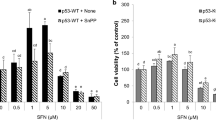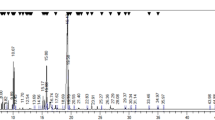Abstract
Isothiocyanate sulforaphane (SFN) is a potent cancer chemopreventive agent. We investigated the mechanisms underlying the anti-proliferative effects of SFN in the human colon carcinoma cell line, HT-29. We demonstrate that SFN inhibits the growth of HT-29 cells in a dose- and time-dependent manner. Treatment of serum-stimulated HT-29 cells with SFN suppressed the re-initiation of cell cycle by inducing a G1 phase cell cycle arrest. At high doses (>25 μM), SFN dramatically induces the expression of p21CIP1 while significantly inhibits the expression of the G1 phase cell cycle regulatory genes such as cyclin D1, cyclin A, and c-myc. This regulation can be detected at both the mRNA and protein levels as early as 4 h post-treatment of SFN at 50 μM. Additionally, SFN activates MAPKs pathways, including ERK, JNK and p38. Exposure of HT-29 cells with both SFN and an antioxidant, either NAC or GSH, completely blocked the SFN-mediated activation of these MAPK signaling cascades, regulation of cyclin D1and p21CIP1 gene expression, and G1phase cell cycle arrest. This finding suggests that SFN-induced oxidative stress plays a role in these observed effects. Furthermore, the activation of the ERK and p38 pathways by SFN is involved in the upregulation of p21CIP1 and cyclin D1, whereas the activation of the JNK pathway plays a contradictory role and may be partially involved in the downregulation of cyclin D1. Because cyclin D1 and p21CIP1 play opposing roles in G1 phase cell cycle progression regulation, blocking the activation of each MAPK pathway with specific MAPK inhibitors, is unable to rescue the SFN-induced G1 phase cell cycle arrest in HT-29 cells.






Similar content being viewed by others
Abbreviations
- SFN:
-
Sulforaphane
- MAPK:
-
Mitogen-activated protein kinase
- NF-κB:
-
Nuclear factor-kappa B
- GSH:
-
Glutathione
- NAC:
-
N-acetyl-L-cysteine
- MTS:
-
3-(4,5-dimethylthiazol-2-yl)-5-(3-carboxyphenyl)-2-(4-sulfophenyl)-2H-tetrazolium, inner salt
- ERK:
-
Extracellular signal-regulated protein kinase JNK, c-Jun NH2-terminal kinase
References
Potter JD, Slattery ML, Bostick RM, Gapstur SM (1993) Colon cancer: a review of the epidemiology. Epidemiol Rev 15:499–545
Steinmetzand KA, Potter JD (1991) Vegetables, fruit, and cancer. I. Epidemiology. Cancer Causes Control 2:325–357
Leoni O, Iori R, Palmieri S (2000) Hydrolysis of glucosinolates using nylon-immobilized myrosinase to produce pure bioactive molecules. Biotechnol Bioeng 68:660–664
Getahunand SM, Chung FL (1999) Conversion of glucosinolates to isothiocyanates in humans after ingestion of cooked watercress. Cancer Epidemiol Biomarkers Prev 8:447–451
Hecht SS, Kenney PM, Wang M, Upadhyaya P (2002) Benzyl isothiocyanate: an effective inhibitor of polycyclic aromatic hydrocarbon tumorigenesis in A/J mouse lung. Cancer Lett 187:87–94
Zhang Y, Kensler TW, Cho CG, Posner GH, Talalay P (1994) Anticarcinogenic activities of sulforaphane and structurally related synthetic norbornyl isothiocyanates. Proc Natl Acad Sci USA 91:3147–3150
Singletaryand K, MacDonald C (2000) Inhibition of benzo[a]pyrene- and 1,6-dinitropyrene-DNA adduct formation in human mammary epithelial cells bydibenzoylmethane and sulforaphane. Cancer Lett 155:47–54
Fahey JW, Haristoy X, Dolan PM, Kensler TW, Scholtus I, Stephenson KK, Talalay P, Lozniewski A (2002) Sulforaphane inhibits extracellular, intracellular, and antibiotic-resistant strains of Helicobacter pylori and prevents benzo[a]pyrene-induced stomach tumors. Proc Natl Acad Sci USA 99:7610–7615
Kassie F, Uhl M, Rabot S, Grasl-Kraupp B, Verkerk R, Kundi M, Chabicovsky M, Schulte-Hermann R, Knasmuller S (2003) Chemoprevention of 2-amino-3-methylimidazo[4,5-f]quinoline (IQ)-induced colonic and hepatic preneoplastic lesions in the F344 rat by cruciferous vegetables administered simultaneously with the carcinogen. Carcinogenesis 24:255–261
Chung FL, Conaway CC, Rao CV, Reddy BS (2000) Chemoprevention of colonic aberrant crypt foci in Fischer rats by sulforaphane and phenethyl isothiocyanate. Carcinogenesis 21:2287–2291
Verhoeven DT, Verhagen H, Goldbohm RA, van den Brandt PA, van Poppel G (1997) A review of mechanisms underlying anticarcinogenicity by brassica vegetables. Chem Biol Interact 103:79–129
Faheyand JW, Talalay P (1999) Antioxidant functions of sulforaphane: a potent inducer of phase II detoxication enzymes. Food Chem Toxicol 37:973–979
Thimmulappa RK, Mai KH, Srisuma S, Kensler TW, Yamamoto M, Biswal S (2002) Identification of Nrf2-regulated genes induced by the chemopreventive agent sulforaphane by oligonucleotide microarray. Cancer Res 62:5196–5203
Langouet S, Furge LL, Kerriguy N, Nakamura K, Guillouzo A, Guengerich FP (2000) Inhibition of human cytochrome P450 enzymes by 1,2-dithiole-3-thione, oltipraz and its derivatives, and sulforaphane. Chem Res Toxicol 13:245–252
Maheo K, Morel F, Langouet S, Kramer H, Le Ferrec E, Ketterer B, Guillouzo A (1997) Inhibition of cytochromes P-450 and induction of glutathione S-transferases by sulforaphane in primary human and rat hepatocytes. Cancer Res 57:3649–3652
Chen YR, Wang W, Kong AN, Tan TH (1998) Molecular mechanisms of c-Jun N-terminal kinase-mediated apoptosis induced by anticarcinogenic isothiocyanates. J Biol Chem 273:1769–1775
Payen L, Courtois A, Loewert M, Guillouzo A, Fardel O (2001) Reactive oxygen species-related induction of multidrug resistance-associated protein 2 expression in primary hepatocytes exposed to sulforaphane. Biochem Biophys Res Commun 282:257–263
Heiss E, Herhaus C, Klimo K, Bartsch H, Gerhauser C (2001) Nuclear factor kappa B is a molecular target for sulforaphane-mediated anti-inflammatory mechanisms. J Biol Chem 276:32008–32015
Gamet-Payrastre L, Li P, Lumeau S, Cassar G, Dupont MA, Chevolleau S, Gasc N, Tulliez J, Terce F (2000) Sulforaphane, a naturally occurring isothiocyanate, induces cell cycle arrest and apoptosis in HT29 human colon cancer cells. Cancer Res 60:1426–1433
Pham NA, Jacobberger JW, Schimmer AD, Cao P, Gronda M, Hedley DW (2004) The dietary isothiocyanate sulforaphane targets pathways of apoptosis, cell cycle arrest, and oxidative stress in human pancreatic cancer cells and inhibits tumor growth in severe combined immunodeficient mice. Mol Cancer Ther 3:1239–1248
Chiao JW, Chung FL, Kancherla R, Ahmed T, Mittelman A, Conaway CC (2002) Sulforaphane and its metabolite mediate growth arrest and apoptosis in human prostate cancer cells. Int J Oncol 20:631–636
Parnaud G, Li P, Cassar G, Rouimi P, Tulliez J, Combaret L, Gamet-Payrastre L (2004) Mechanism of sulforaphane-induced cell cycle arrest and apoptosis in human colon cancer cells. Nutr Cancer 48:198–206
Haristoy X, Angioi-Duprez K, Duprez A, Lozniewski A (2003) Efficacy of sulforaphane in eradicating Helicobacter pylori in human gastric xenografts implanted in nude mice. Antimicrob Agents Chemother 47:3982–3984
Singh AV, Xiao D, Lew KL, Dhir R, Singh SV (2004) Sulforaphane induces caspase-mediated apoptosis in cultured PC-3 human prostate cancer cells and retards growth of PC-3 xenografts in vivo. Carcinogenesis 25:83–90
Johnsonand DG, Walker CL (1999) Cyclins and cell cycle checkpoints. Annu Rev Pharmacol Toxicol 39:295–312
Weinstein IB (2000) Disorders in cell circuitry during multistage carcinogenesis: the role of homeostasis. Carcinogenesis 21:857–64
Chan-Huiand PY, Weaver R (1998) Human mitogen-activated protein kinase kinase kinase mediates the stress-induced activation of mitogen-activated protein kinase cascades. Biochem J 336(Pt 3):599–609
Terada Y, Inoshita S, Nakashima O, Kuwahara M, Sasaki S, Marumo F (1999) Regulation of cyclin D1 expression and cell cycle progression by mitogen-activated protein kinase cascade. Kidney Int 56:1258–1261
Kerkhoffand E, Rapp UR (1998) Cell cycle targets of Ras/Raf signalling. Oncogene 17:1457–1462
Gamet-Payrastre L, Lumeau S, Gasc N, Cassar G, Rollin P, Tulliez J (1998) Selective cytostatic and cytotoxic effects of glucosinolates hydrolysis products on human colon cancer cells in vitro. Anticancer Drugs 9:141–148
Xiong Y, Hannon GJ, Zhang H, Casso D, Kobayashi R, Beach D (1993) p21 is a universal inhibitor of cyclin kinases. Nature 366: 701–704
Toyoshimaand H, Hunter T (1994) p27, a novel inhibitor of G1 cyclin-Cdk protein kinase activity, is related to p21. Cell 78:67–74
Granaand X, Reddy EP (1995) Cell cycle control in mammalian cells: role of cyclins, cyclin dependent kinases (CDKs), growth suppressor genes and cyclin-dependent kinase inhibitors (CKIs). Oncogene 11:211–219
Hofseth LJ, Hussain SP, Harris CC (2004) p53: 25 years after its discovery. Trends Pharmacol Sci 25:177–181
Paggi MG, Baldi A, Bonetto F, Giordano A (1996) Retinoblastoma protein family in cell cycle and cancer: a review. J Cell Biochem 62:418–430
Chen C, Shen G, Hebbar V, Hu R, Owuor ED, Kong AN (2003) Epigallocatechin-3-gallate-induced stress signals in HT-29 human colon adenocarcinoma cells. Carcinogenesis 24:1369–1378
Albanese C, Johnson J, Watanabe G, Eklund N, Vu D, Arnold A, Pestell RG (1995) Transforming p21ras mutants and c-Ets-2 activate the cyclin D1 promoter through distinguishable regions. J Biol Chem 270:23589–23597
Lavoie JN, L‘Allemain G, Brunet A, Muller R, Pouyssegur J (1996) Cyclin D1 expression is regulated positively by the p42/p44MAPK and negatively by the p38/HOGMAPK pathway. J Biol Chem 271:20608–20616
Rooversand K, Assoian RK (2000) Integrating the MAP kinase signal into the G1 phase cell cycle machinery. Bioessays 22:818–826
Oh SY, Park KS, Kim JA, Choi KY (2002) Differential modulation of zinc-stimulated p21(Cip/WAF1) and cyclin D1 induction by inhibition of PI3 kinase in HT-29 colorectal cancer cells. Exp Mol Med 34:27–31
Yu R, Lei W, Mandlekar S, Weber MJ, Der CJ, Wu J, Kong AT (1999) Role of a mitogen-activated protein kinase pathway in the induction of phase II detoxifying enzymes by chemicals. J Biol Chem 274: 27545–27552
Yu R, Mandlekar S, Lei W, Fahl WE, Tan TH, Kong AT (2000) p38 mitogen-activated protein kinase negatively regulates the induction of phase II drug-metabolizing enzymes that detoxify carcinogens. J Biol Chem 275:2322–2327
Kim BR, Hu R, Keum YS, Hebbar V, Shen G, Nair SS, Kong AN (2003) Effects of glutathione on antioxidant response element-mediated gene expression and apoptosis elicited by sulforaphane. Cancer Res 63:7520–7525
Paolini M, Perocco P, Canistro D, Valgimigli L, Pedulli GF, Iori R, Croce CD, Cantelli-Forti G, Legator MS, Abdel-Rahman SZ (2004) Induction of cytochrome P450, generation of oxidative stress and in vitro cell-transforming and DNA-damaging activities by glucoraphanin, the bioprecursor of the chemopreventive agent sulforaphane found in broccoli. Carcinogenesis 25:61–67
Shtutman M, Zhurinsky J, Simcha I, Albanese C, D’Amico M, Pestell R, Ben-Ze’ev A (1999) The cyclin D1 gene is a target of the beta-catenin/LEF-1 pathway. Proc Natl Acad Sci USA 96:5522–5527
Tetsuand O, McCormick F (1999) Beta-catenin regulates expression of cyclin D1 in colon carcinoma cells. Nature 398:422–426
Baldwin AS Jr, Azizkhan JC, Jensen DE, Beg AA, Coodly LR (1991) Induction of NF-kappa B DNA-binding activity during the G0-to-G1 transition in mouse fibroblasts. Mol Cell Biol 11:4943–4951
Joyce D, Bouzahzah B, Fu M, Albanese C, M. D’Amico, Steer J, Klein JU, Lee RJ, Segall JE, Westwick JK, Der CJ, Pestell RG (1999) Integration of Rac-dependent regulation of cyclin D1 transcription through a nuclear factor-kappaB-dependent pathway. J Biol Chem 274:25245–25249
Suzui M, Masuda M, Lim JT, Albanese C, Pestell RG, Weinstein IB (2002) Growth inhibition of human hepatoma cells by acyclic retinoid is associated with induction of p21(CIP1) and inhibition of expression of cyclin D1. Cancer Res 62:3997–4006
Jeong WS, Kim IW, Hu R, Kong AN (2004) Modulatory properties of various natural chemopreventive agents on the activation of NF-kappaB signaling pathway. Pharm Res 21:661–670
Garteland AL, Tyner AL (1998) The growth-regulatory role of p21 (WAF1/CIP1). Prog Mol Subcell Biol 20:43–71
Acknowledgements
This work was supported in part by NIH Grant R01 CA-073674-07. The authors thank Ms. Patra Pharm in the Flow Cytometry Core Facility for her excellent assistance.
Author information
Authors and Affiliations
Corresponding author
Rights and permissions
About this article
Cite this article
Shen, G., Xu, C., Chen, C. et al. p53-independent G1 cell cycle arrest of human colon carcinoma cells HT-29 by sulforaphane is associated with induction of p21CIP1 and inhibition of expression of cyclin D1. Cancer Chemother Pharmacol 57, 317–327 (2006). https://doi.org/10.1007/s00280-005-0050-3
Received:
Accepted:
Published:
Issue Date:
DOI: https://doi.org/10.1007/s00280-005-0050-3




